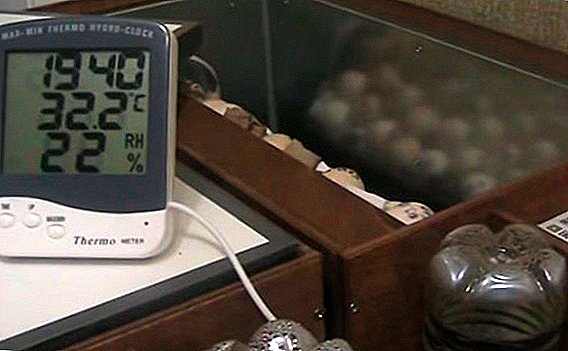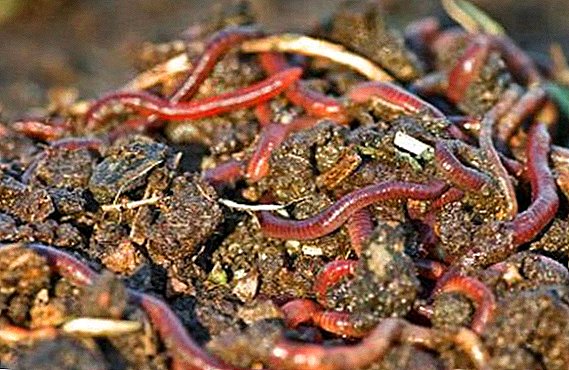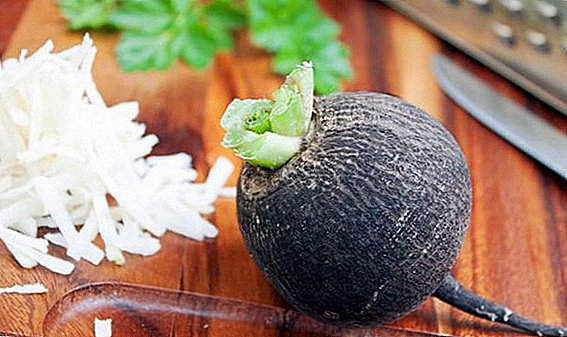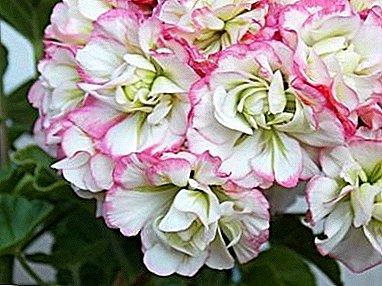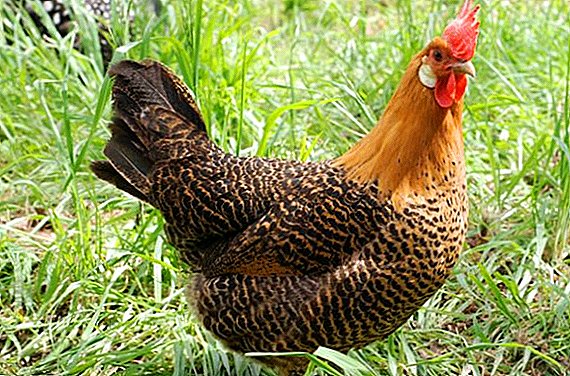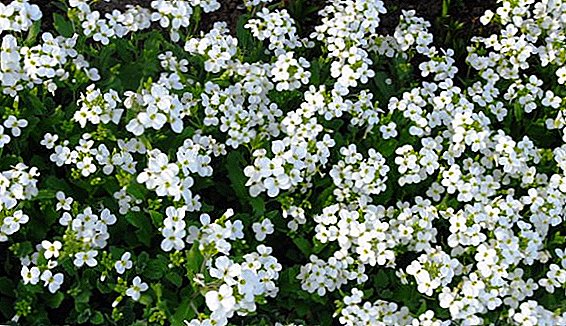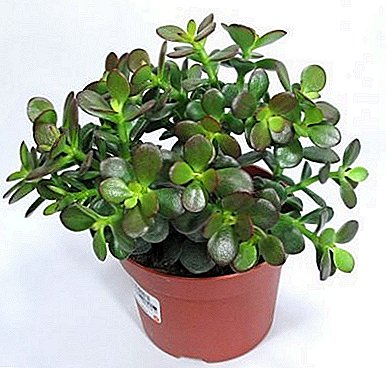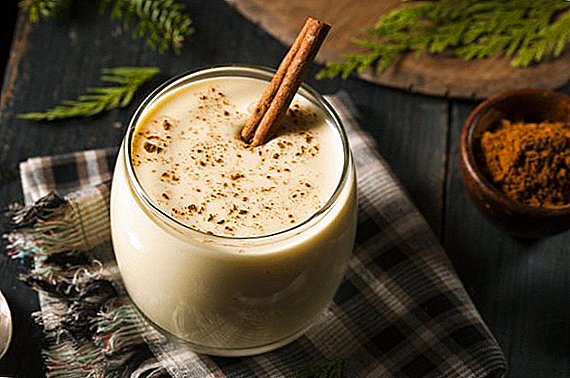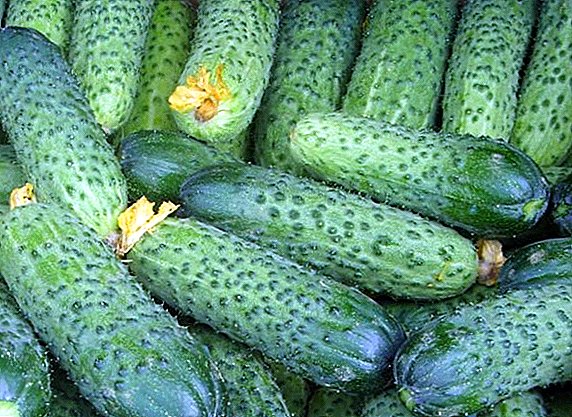 In order to get a good crop of cucumbers, you need to take a responsible approach to the choice of variety.
In order to get a good crop of cucumbers, you need to take a responsible approach to the choice of variety.
They are both pollinated by bees, and self-pollinated. These include cucumber variety "Merenga".
Let's take a closer look at all of its characteristics and growing technology.
Variety description
Cucumbers "Meringue F1" is a new hybrid self-pollinating early variety bred by Dutch breeders. It differs from other varieties of good yield and excellent taste.  The plant is tall and has bundle ovaries. It contains a lot of vitamins, minerals and salts, and also promotes excellent digestion. Also "Merengue F1" is a dietary product, since 100 g contains only 13 kcal.
The plant is tall and has bundle ovaries. It contains a lot of vitamins, minerals and salts, and also promotes excellent digestion. Also "Merengue F1" is a dietary product, since 100 g contains only 13 kcal.
The size of cucumbers is 10-14 cm and a diameter of 3-4 cm. The mass of one cucumber is 80-100 g. The fruit has a one-dimensional appearance with hilly whitish spikes. Color - dark green with thin skin and no voids inside.
Also, this variety is not bitter. Cucumbers can be used to make fresh salads, and they are also suitable for preservation.
Did you know? ABOUT95% gurets consists of water.
The advantages and disadvantages of the variety
The variety "Meringue" has the following advantages:
- excellent taste;
- ripens in a relatively short period;
- big harvest;
- beautiful presentation;
- the duration of storage of the crop;
- cucumbers do not grow to huge sizes.
Among the shortcomings, there is a poor resistance to certain diseases. 
Features and differences from other varieties
The peculiarity and the main difference from non-hybrid varieties is that the "Meringue F1" is a hybrid variety, which was bred by crossing two or more cucumber varieties.
Due to this, it is better adapted to fluctuations in temperature, boasts increased yields, attractive appearance and early maturity. But it is also worth knowing that in the second generation hybrids are fruitless. Therefore, it makes no sense to independently collect seeds.
Check out such cucumber varieties as Spring, Siberian Festoon, Hector, Emerald Earrings, Crispina, Taganay, Palchik, Lukhovitsky, Real Colonel, Masha, "Competitor", "Zozulya", "Courage".
Cultivation
The cultivation technology of cucumber "Merengue" is that they should be planted on the soil well prepared for planting. It should be loose, well absorb water and have a minimum level of acidity.  It is best to plant cucumbers in the places where onions, peppers, corn, cabbage were previously grown.
It is best to plant cucumbers in the places where onions, peppers, corn, cabbage were previously grown.
Before planting cucumbers, the soil should be fertilized. It is also necessary to wait until the soil temperature reaches the level of + 14-15 ° С and finally all night frosts are bypassed.
Important! It is better to plant cucumbers every time on a new plot of land - no more than once every 5 years at the same place.This hybrid can be grown from both seeds and seedlings. You can choose the way that suits you. Growing seeds easier, and from seedlings you get a harvest faster. The best way to grow Merengue F1 is in a greenhouse or greenhouse.
The optimum temperature for growing seedlings is + 22-27 ° C. It is planted in the tank, each sprout separately, and after about a month it is ready for seating in the open ground.  If you want to plant seeds immediately in the ground, you need to make holes 2-3 cm deep, between the rows there should be at least 50-60 cm. For a good crop of cucumbers you need to find a suitable soil on which potatoes, cabbage, onions were previously grown.
If you want to plant seeds immediately in the ground, you need to make holes 2-3 cm deep, between the rows there should be at least 50-60 cm. For a good crop of cucumbers you need to find a suitable soil on which potatoes, cabbage, onions were previously grown.
When the seeds are planted, the top can be covered with foil. When the first sprouts grow, the ground around it should be loosened.
Fruit "Meringue" starts in 40-55 days, depending on what type of cultivation you choose.
Learn about the intricacies of growing cucumbers in the open field, in the greenhouse, in plastic bottles, in buckets, on the balcony, in bags, on the windowsill.
Care
Cucumbers "Merengue F1" need, like all plants, in the standard care. Timely watering, weeding and loosening the soil will give their results.  The shoots must have enough light, and for this they need to be pinch off correctly. To the level of 60 cm, if there are flowers or shoots 2-5 cm long in the leaf axils, they should be removed. You also need to remove from the stems at a height of one meter on one leaf and fruit.
The shoots must have enough light, and for this they need to be pinch off correctly. To the level of 60 cm, if there are flowers or shoots 2-5 cm long in the leaf axils, they should be removed. You also need to remove from the stems at a height of one meter on one leaf and fruit.
Watering
Plants require moderate daily watering. But by the time when cucumbers begin to bloom and bear fruit, the amount of water consumed by the plant increases.
Important! Watering cucumbers is better with watering cans and sprays to avoid soil compaction and damage to the root system. Jet water cucumbers should not be.
Fertilizer
Fertilizing "Merengue" is best organic fertilizers during the entire period of growth and flowering. 
Still used such compounds:
- "Cucrystal cucumber" - 1-2 g of product per 1 l of water, used at the rate of 250 l per 1 ha.
- 400 g of ammonium nitrate mixed with 400 g of double superphosphate, 300 g of potassium sulfate, 100 g of iron, 20 g of boric acid and copper sulphate per 100 l of water.
- a solution of 100 l of water, 200 g of urea, 100 g of potassium sulfate, 150 g of superphosphate.
It is better to introduce all fertilizers with the help of a drip irrigation system.
Did you know? The name "cucumber" comes from the ancient Greek word "aguros", which means "not ripe."
Reviews
In most cases, the variety "Meringue F1" collects only positive reviews, as it has good taste, attractive appearance and great harvest.  There are dissatisfied with this variety, but this may be due to non-compliance with the rules of cultivation, or simply poor-quality seeds.
There are dissatisfied with this variety, but this may be due to non-compliance with the rules of cultivation, or simply poor-quality seeds.
As we have seen, the cultivation of the "Merengue F1" variety does not require any special wisdom, and the result is worth the effort that will have to be made to get an excellent harvest.


